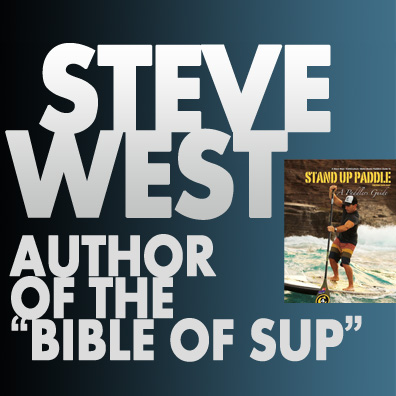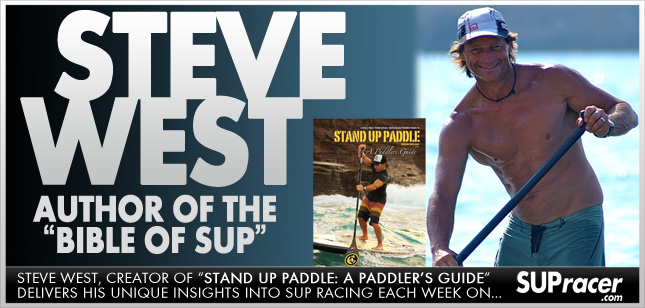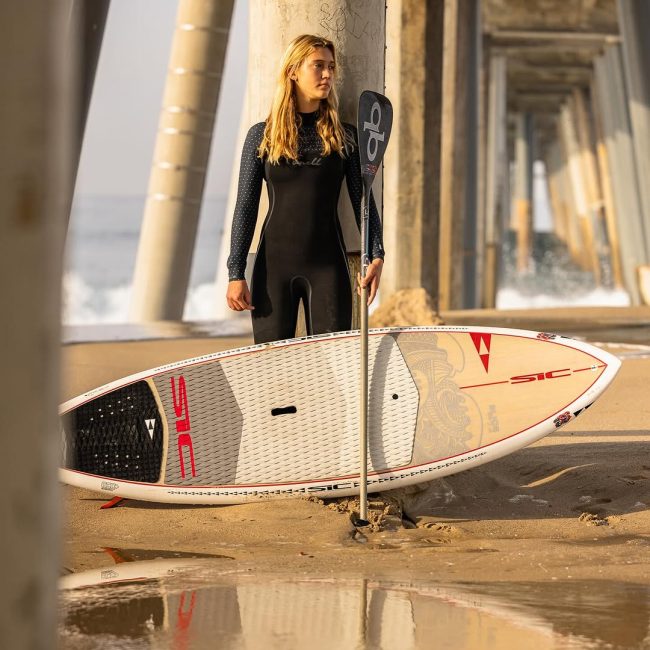
The Box Rule, The Missing 18 Inches, A Cultural Clash And A Race Director’s Nightmare

Boss Man’s note: Last week Steve West stirred up the bees nest with his strongly worded guest post about board design & restrictions. We loved the response from you guys, even if half of it was negative (how boring would it be if we all agreed?), so we’re back this week to throw Steve to the lions once more.
So click through to hear Steve’s latest piece, and, as always, leave your comment below if you agree/disagree/love it/hate it…
MORE >>> Take a look at Steve’s previous posts about Stand Up Paddling and then if you wanna hear more, go grab his excellent SUP book as well.
*****
The ‘Box Rule’ the Missing 18″ a Cultural Clash and a Race Directors Nightmare
by Steve West
I’ll start by concurring with Jim Terrell right off the bat . . . there are too many race divisions. Surf Board, 12’6″ Rigid, 12’6″ iSUP, 14′ Rigid, 14′ iSUP, Unlimited, Male, Female and all the potential age divisions in-between and to top if off, Novice and Elite and I’m sure we can create some others.
At the University of Hawaii in 1995, Hanni Anderson from HCRA concluded, “Old paddlers don’t retire, they just form new divisions!” On the back of the Battle of the Thames race, as big a success as it was, the number of divisions, even without the added issue of age or unlimited divisions, was off the scale, but on the upside it contributed to weight of numbers, but it’s not a race when you’re catering to only one person in that particular division which defeats the purpose and leads to boxes of unused medals.
“Ah, the Old Box Rule!” you exclaim. The Box Rule is a ruling typically applied to varying forms of sail powered craft and is a simplified version of the long standing Formula Based applied ruling (where water line length is factored into a complex equation).
“A maximum length, maximum beam, maximum crew number and maximum sail area is applied together with no other rules. No credit is given for being less than the factors and no formula for trading the various factors. The boat either meets all the limits of the box or it doesn’t. This system is very ‘type’ forming . . . a box rule can also be very simple with lots of latitude for designers. In a rule where length, sail area, displacement, stability and the other factors are traded (water line length) an effort is made to see that they are traded in proportion to their value in producing boat speed . . . the designers job becomes one of trading the “go slow” factors against the “go fast” factors, whereas under a box rule, the designer only has “go fast” factors to work with.”
So in this context, we could apply a Box Rule to SUP race boards, but it would be more likely to stipulate a ‘maximum length and a minimum beam’ and designers would exploit these two ‘go fast’ factors – a minimum weight may certainly address any socio-economic issues.
If there is serious headway down an Olympic pathway, which embraces flat water sprints or marathons, there’s every likelihood boards will be of the stand-inside form to compensate for fast, semi-displaced hulls. Narrowness will not be the ultimate ‘limiter’ in terms of extremes of performance in this instance, but more significantly, cross-sectional curvature in creating semi-displaced hulls with low drag co-efficient figures as akin to C1 and K1 designs, which begs the question, how will we prevent radically fast, unstable boards being created within the framework of the box rule limits?
In the context of our current rulings in the absence of a beam ruling, designers are already testing the limits of width and varying (shortening) water line lengths relative to the board’s application bringing about concern that only elite athletes will be able to paddle super narrow boards. It’s human nature to test these limits, but I think we should have faith that a self governing process will resolve this – too narrow and it will be a struggle to apply adequate pressure to the blade, limiting sales on account of limited appeal, but this could be argued out either way and is more likely to be the domain of true flat water race boards to come or those which may be reserved for racing under the governance of any one particular organization.
“The designers very quickly figured out that to maximize speed in a box rule class you have to maximize waterline length.”
We agree that water line length is a significant issue when wanting to maximize speed, but the rules currently applied to SUP boards do not account for water line length or beam, but if they did, a 14′ board with a water line length of only 12′ may be permitted to race in the 12’6″ division, after all, we are not talking yachts powered by sails. Inevitably it’s a moot point and I concede, it’s in the too hard basket; it’s more the point than the principal.
Cost, Transportation and Storage Issues Reign over Performance
When the pros and cons of board length issues are accounted for, they generally come down to cost, transportation and storage issues. This being the case, we can conclude that the evolution of the board in terms of performance, is very probably secondary to all other concerns (for many) and this is where conflict is arising. I am all for the evolution of the board first and consideration of all other factors second – only on account of the fact, I would like to know what is possible and ultimately what is most pleasurable to be on.
A few things seem clear. Those racing and traveling many miles with equipment, struggle to travel with two boards, while some race organizers are struggling to accommodate and please all paddlers with regards which division they apply the most kudos, balanced with courses to suit.
A few thoughts . . .
BOP race board specs are the most perplexing. Established early on in the sport’s evolution, they manifested 12’6″ boards fit for purpose, but not so fit for grinding out mile after mile over flat water in comparison to the longer board. Consequently, newly founded ‘flat’ races taking place over longer distances, which subsequently demand the 12’6” board be used over the superior (faster) alternative, seems out of context, but many folk have invested this way and it will take time for this to change, but change I think it must.
If we applied a broader singular length range which stipulates, ‘race boards may be of any dimension not exceeding 14′ . . .’ we ensure ‘fairness’ and the application of free-will to use what best suits the individual, race distance and conditions. This would not negate 12’6″ boards from continuing to be produced or competed upon and presumably, paddlers have already determined which board length suits them best, unless of course they have chosen simply on the basis of cost, transportation and storage, rather than performance.
With a broader ruling, paddlers would choose what board they could feasibly handle during a BOP contest given the prevailing conditions, which establishes a self-governing process which would open the field up to to all-comers. This is countered with the reasoning a 12’6″ board for this styled event, should be preferred as it supports good risk management on account of handling qualities.
If ‘safety first’ is our mantra, iSUP boards create a valid case for their use in order to limit impact injury. I say this not because I think it should be so, I’m just pointing it out as someone else will . . . we have a ‘safer’ alternative if safety were ever a major concern and it would resolve a plethora of transportation and storage issues – but then it would come down to performance issues. (Please don’t have a melt down over this suggestion – it’s mentioned because it’s possible not necessarily because it’s plausible).
While the Unlimited board must be permitted to thrive in exploring the maxims of performance, mixing all three board divisions within the one race (more especially flat water) which results in an Unlimited board paddler winning line honors, only to be considered secondary to the main event, is profoundly confusing for the media and spectators. Significantly, this appears to have contributed to marginalizing the Unlimited division rather than revering it, in contrast to the Unlimited division within prone, which is where the kudos exists in being fastest and first over the line more often than not on account of a faster hull speed given the status-quo. Regardless, the resultant mix is not a good one, but fortunately in the context of big water downwind events, the goal posts and kudos tends to shift in favor of the Unlimited board.
A Cultural Clash
We’ve reached an inevitable juncture, as new event types and durations are created and differing paddle sport enthusiasts from widely diverse geographical parts of the world enter the sport, who in turn bring their interpretations and even their fears with them; fears of over-regulation, fears of not being regulated enough. The flat water racer seems to want more regulation to deal with the constant of flat water, while the open water paddler seems to want little regulation in order to deal with the lack thereof and so in truth, it’s not going to be entirely possible to please everyone, but I would suggest that these two distinct ‘camps’ if we can call them that, will no doubt get their way in the fullness of time.
It’s clear beyond any reasonable doubt that we have created a situation not in everyone’s best interests. Inevitably, irrevocably, we impose limits because we can and we should, because it’s only fair to do so, above all else it honors our obsession with rule making and an assurance that where too much latitude exists for creativity or freedom of expression, we should rush to shut this down and in doing so, we may unwittingly protect an industry that doesn’t want us to have too much choice, to which we as participants, full-heartedly agree that this is surely the best way forward. The best caveat for rule making is more often than not safety, but should never be about limiting enjoyment. Culturally speaking this is an uphill battle, because our essential nature, revels in defining boundaries, limits and rulings, even if imposed on something meant to be fun, beyond work and the limitations imposed on everyday life.
Choices and the Missing 18″
There’s obviously concern we will end up with an infinite number of choices of race board lengths to choose from if there were no length rulings, but at days end, some form of length ruling it seems is ‘wanted’ – in difference to perhaps being‘needed’. But what of the missing 18″ loitering between 12’6″ and 14′ and just what are we missing out on in terms of performance and why should we not be permitted to exploit them?
What of the possibility that right now, the well prepared SUP racer should perhaps possess a variety of board designs for a variety of conditions regardless of what length board they prefer. No amount of divine intervention will manifest a board which can do it all, which suggests you may very well need more than one board, though once again for the traveling racer, this is problematic, hence why the all-round race board in some sense, is manifesting out of necessity.
“There needs to be no scientific reason for the 12’6 class or any other for that matter. It’s a matter of convention.”
If the science isn’t important, then neither should the need to establish any rulings and insofar as convention is concerned, the sport is too new to subscribe to a convention. The essential thrust of the discussion was initially centred upon trying to point out the relevance of water line length (as a science) when discussing any rationale for issues of hull speed, fairness or limits of overall length. It’s been suggested this is not relevant, but when we only have one singular governing rule of length overall, it must be conceded this lends itself to some level of inquisition.
Board Designs Against the Grain
While some may believe all SUP designers are ensuring the maximum use of water line length at this point in time with regards race board designs, the fact of the matter is, this is simply not the case and indeed it is very probably those who are breaking free from this line of thought, who are pioneering a specific evolutionary pathway, as against those following what might be considered ‘conventional’ thought in recognizing, most race conditions have at least some surface movement.
Let’s consider this for a moment and take one example in Dave Parmenter’s C4 12’6″ TGIF Pro Race design. Aussie Travis Grant dominated with this board at the SUP Survivor Race of 2012, beating Danny Ching, JM and Connor Baxter, a board which has an unladen water line length of around 10′ on account of the fore to aft rocker and up-swept bow line which ensures the bow is constantly ‘disengaged’ as it were, the water passing under the level of the upper bow, to meet a genuine semi-displaced hull underneath.
Giving away this much water line length to his rivals, you might conclude he would have stood little or no chance of winning on what were by any ocean paddlers standards ‘flat’ conditions? Travis Grant’s new NSP boards do not use their full overall length and so far he has been unbeaten in Australia in recent months and with a summer of racing coming up in Europe, it will be interesting to see which boards married up with which paddlers, excel in relation to what distances and what conditions.
We’ve a long way to go it seems.
© Steve West 2013



